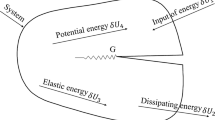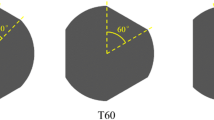Abstract
Tool parameters play a vital role in the mechanical interlock formation during the flat clinching process. To understand the influence of tool parameters on the interlock formation, the finite element software DEFORM-2D was used to build the numerical model of the flat clinching process, and the numerical model was verified by the experiment. The influences of the punch radius, punch fillet radius, and blank holder radius on the interlock formation of the clinched joint were investigated using the numerical model. Then, the relationship between the punch radius and blank holder radius was studied. The results showed that the interlock gradually increases with the increase of the blank holder radius; after that, the interlock begins to decrease. To maximize the interlock, the punch radius and the blank holder radius should be increased simultaneously. It can be concluded that the blank holder radius and the punch radius should keep a linear relationship when designing the geometric dimensions of the flat clinch tools, which can promote the application of the flat clinching process in car body manufacturing.


















Similar content being viewed by others
Data Availability
All data generated or analyzed during this study are included in the present article.
References
Dilthey U, Stein L (2013) Multimaterial car body design: challenge for welding and joining. Sci Technol Weld Joining 11(2):135–142. https://doi.org/10.1179/174329306x85967
Meschut G, Hahn O, Janzen V, Olfermann T (2014) Innovative joining technologies for multi-material structures. Weld World 58(1):65–75. https://doi.org/10.1007/s40194-013-0098-3
Salamati M, Soltanpour M, Fazli A, Zajkani A (2019) Processing and tooling considerations in joining by forming technologies; part a—mechanical joining. Int J Adv Manuf Technol 101(1):261–315. https://doi.org/10.1007/s00170-018-2823-y
Galińska A, Galinski C (2020) Mechanical joining of fibre reinforced polymer composites to metals—a review. Part II: riveting, clinching, non-adhesive form-locked joints pin and loop joining. Polym 12(8):1681. https://doi.org/10.3390/polym12081681
Wang J, Yu Y, Fu C, Xiao H, Wang H, Zheng X (2020) Experimental investigation of clinching CFRP/aluminum alloy sheet with prepreg sandwich structure. J Mater Process Technol. 277:116422. https://doi.org/10.1016/j.jmatprotec.2019.116422
He X (2017) Clinching for sheet materials. Sci Technol Adv Mater 18(1):381–405. https://doi.org/10.1080/14686996.2017.1320930
Gerstmann T, Awiszus B (2020) Hybrid joining: numerical process development of flat-clinch-bonding. J Mater Process Technol 277:116421. https://doi.org/10.1016/j.jmatprotec.2019.116421
Chen C, Zhao S, Cui M, Han X, Fan S, Ishida T (2016) An experimental study on the compressing process for joining Al6061 sheets. Thin-Walled Struct 108:56–63. https://doi.org/10.1016/j.tws.2016.08.007
Chen C, Zhao S, Han X, Cui M, Zhao X, Ishida T (2017) Experimental investigation of the mechanical reshaping process for joining aluminum alloy sheets with different thicknesses. J Manuf Processes 26(4):105–112. https://doi.org/10.1016/j.jmapro.2017.01.015
Chen C, Zhao S, Cui M, Han X, Fan S (2016) Mechanical properties of the two-steps clinched joint with a clinch-rivet. J Mater Process Technol 237:361–370. https://doi.org/10.1016/j.jmatprotec.2016.06.024
Lambiase F, Ko D-C (2017) Two-steps clinching of aluminum and carbon fiber reinforced polymer sheets. Compos Struct 164:180–188. https://doi.org/10.1016/j.compstruct.2016.12.072
Peng H, Chen C, Zhang H, Ran X (2020) Recent development of improved clinching process. Int J Adv Manuf Technol 110(11):1–31. https://doi.org/10.1007/s00170-020-05978-4
Wen T, Huang Q, Liu Q, Ou W-X, Zhang S (2016) Joining different metallic sheets without protrusion by flat hole clinching process. Int J Adv Manuf Technol 85(1):217–225. https://doi.org/10.1007/s00170-015-7936-y
Beyer U, Awiszus B (2010) Flat-clinching-a new possibility for joining different kinds of components in a flexible and effective way to a planar material com-pound. Steel Res Int 81:1124–1127
Lüder S, Hartel S, Binotsch C, Awiszus B (2014) Influence of the moisture content on flat-clinch connection of wood materials and aluminium. J Mater Process Technol 214(10):2069–2074. https://doi.org/10.1016/j.jmatprotec.2014.01.010
Han X, Zhao S, Chen C, Liu C, Xu F (2017) Optimization of geometrical design of clinching tools in flat-clinching. Proc Inst Mech Eng, Part C: J Mech Eng Sci 231(21):4012–4021. https://doi.org/10.1177/0954406216660335
Chen C, Zhao S, Han X, Wang Y, Zhao X (2017) Investigation of flat clinching process combined with material forming technology for aluminum alloy. Mater 10(12):1433. https://doi.org/10.3390/ma10121433
Sabra Atia MK, Jain MK (2017) Die-less clinching process and joint strength of AA7075 aluminum joints. Thin-Walled Struct 120:421–431. https://doi.org/10.1016/j.tws.2017.06.021
Atia MKS, Jain MK (2018) Finite element analysis of material flow in die-less clinching process and joint strength assessment. Thin-Walled Struct 127:500–515. https://doi.org/10.1016/j.tws.2018.03.001
Atia MKS, Jain MK (2020) A novel approach to hot die-less clinching process for high strength AA7075-T6 sheets. Proc Inst Mech Eng, Part C: J Mech Eng Sci 234(19):17. https://doi.org/10.1177/0954406220917406
Chen C, Zhang H, Xu Y, Wu J (2020) Investigation of the flat-clinching process for joining three-layer sheets on thin-walled structures. Thin-Walled Struct. 157:107034. https://doi.org/10.1016/j.tws.2020.107034
Feng F, Li JJ, Yuan P, Zhang QX, Huang P, Su HL, Chen RC (2018) Application of a GTN damage model predicting the fracture of 5052-O aluminum alloy high-speed electromagnetic impaction. Metals 8(10):761–780. https://doi.org/10.3390/met8100761
Lambiase F (2015) Mechanical behaviour of polymer–metal hybrid joints produced by clinching using different tools. Mater Des 87:606–618. https://doi.org/10.1016/j.matdes.2015.08.037
Gerstmann T, Awiszus B (2014) Recent developments in flat-clinching. Comput Mater Sci 81:39–44. https://doi.org/10.1016/j.commatsci.2013.07.013
Flodr J, Lehner P, Krejsa MJS (2020) Experimental and numerical evaluation of clinch connections of thin-walled building structures. Sustain 12(14):5691. https://doi.org/10.3390/su12145691
Tenorio MB, Lajarin SF, Gipiela ML, Marcondes PVP (2019) The influence of tool geometry and process parameters on joined sheets by clinching. J Braz Soc Mech Sci Eng 41(2):67. https://doi.org/10.1007/s40430-018-1539-0
Barimani-Varandi A, Aghchai AJJM (2020) Electrically-assisted mechanical clinching of AA6061-T6 aluminum to galvanized DP590 steel: effect of geometrical features on material flow and mechanical strength. Mech Ind 21(5):529. https://doi.org/10.1051/meca/2020072
Lambiase F, Di Ilio A (2013) Finite element analysis of material flow in mechanical clinching with extensible dies. J Mater Eng Perform 22(6):1629–1636. https://doi.org/10.1007/s11665-012-0451-5
Funding
The authors acknowledge funding by the National Nature Science Foundation of Shandong Province of China (grant no. ZR2018MEE024 and ZR2020KE051), the Project of Shandong Province Higher Educational Science and Technology Program (grant no. J17KA018), and the Binzhou University Doctoral Research Initiation Fund Project (grant no. 2016Y06).
Author information
Authors and Affiliations
Contributions
Not applicable.
Corresponding author
Ethics declarations
Ethical approval
This research did not involve human participants or animals; thus, ethics approval is not necessary.
Consent to participate
Not applicable.
Consent for publication
Not applicable.
Competing interests
The authors declare no competing interests.
Additional information
Publisher's note
Springer Nature remains neutral with regard to jurisdictional claims in published maps and institutional affiliations.
Rights and permissions
Springer Nature or its licensor (e.g. a society or other partner) holds exclusive rights to this article under a publishing agreement with the author(s) or other rightsholder(s); author self-archiving of the accepted manuscript version of this article is solely governed by the terms of such publishing agreement and applicable law.
About this article
Cite this article
Wang, Z., Han, S., Li, Z. et al. Numerical investigation of tool parameter influence on the interlock forming during flat clinching process. Int J Adv Manuf Technol 126, 301–311 (2023). https://doi.org/10.1007/s00170-023-11118-5
Received:
Accepted:
Published:
Issue Date:
DOI: https://doi.org/10.1007/s00170-023-11118-5




